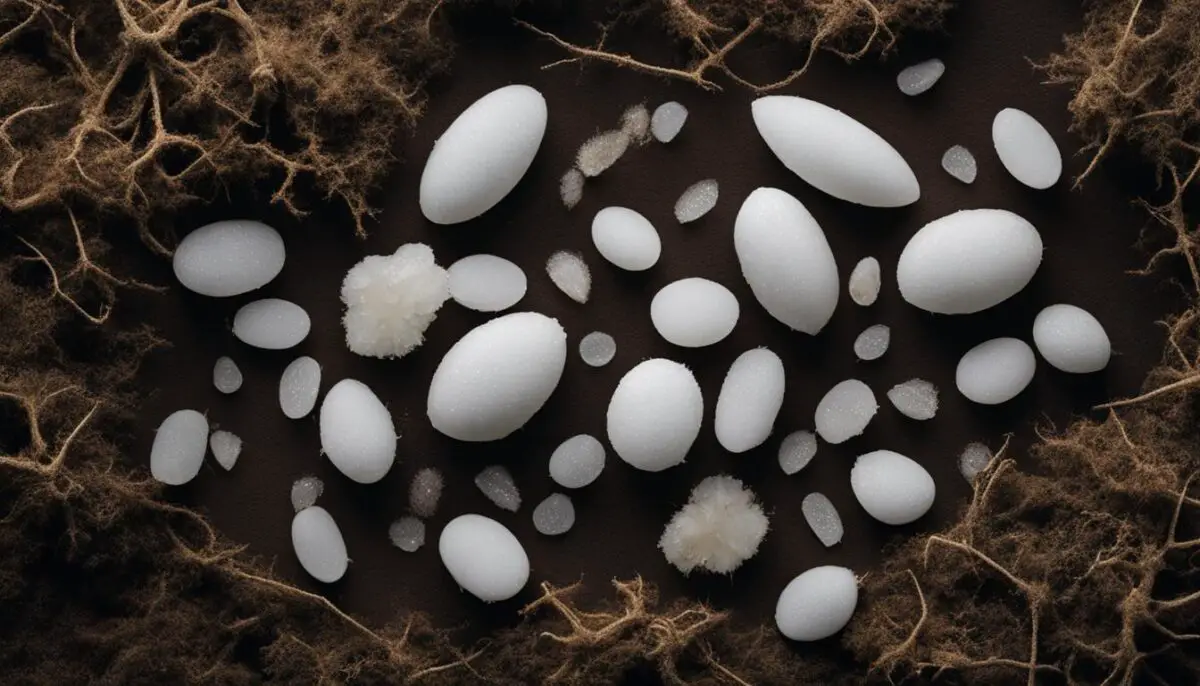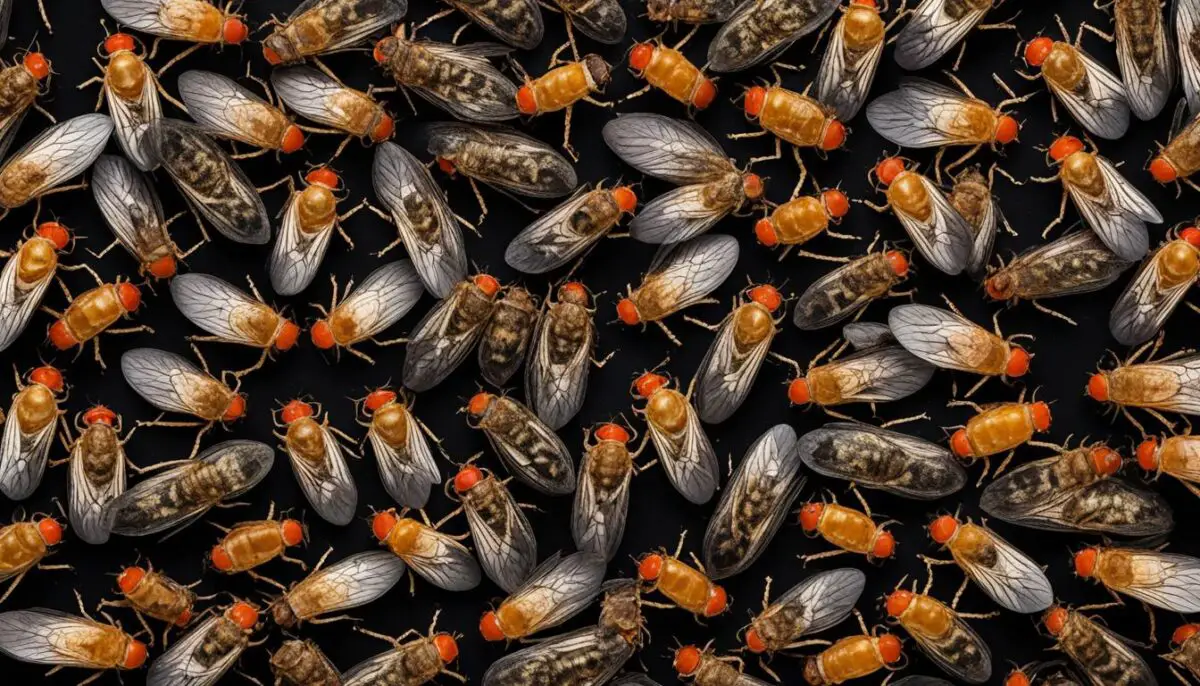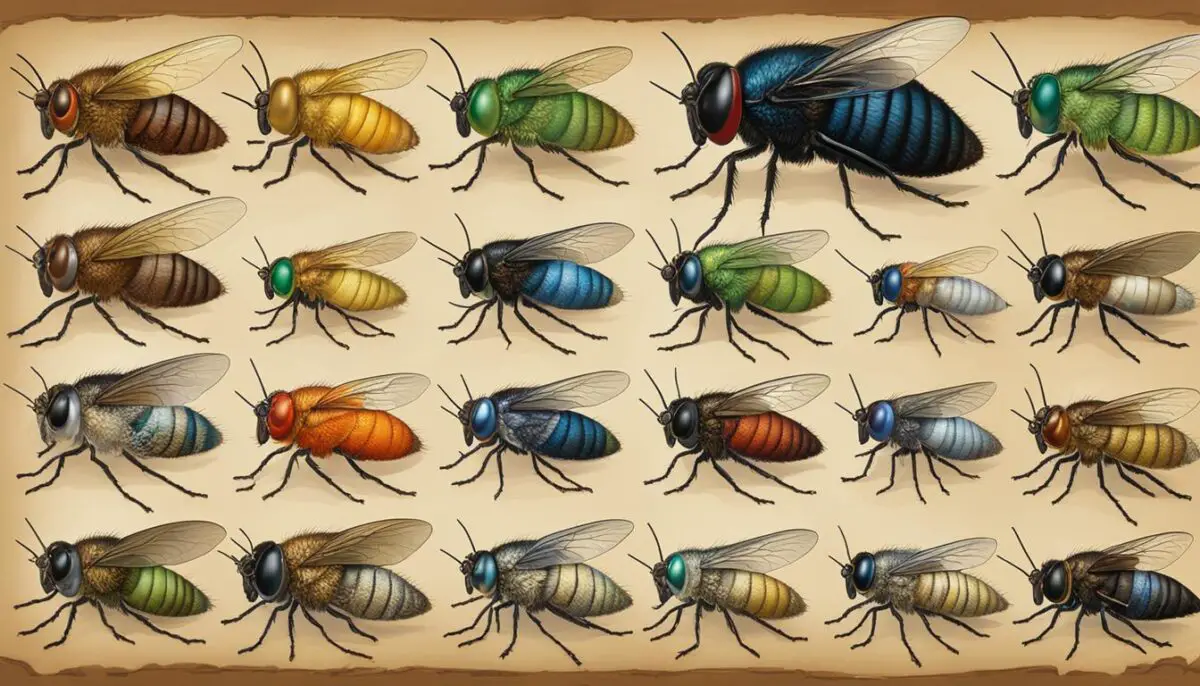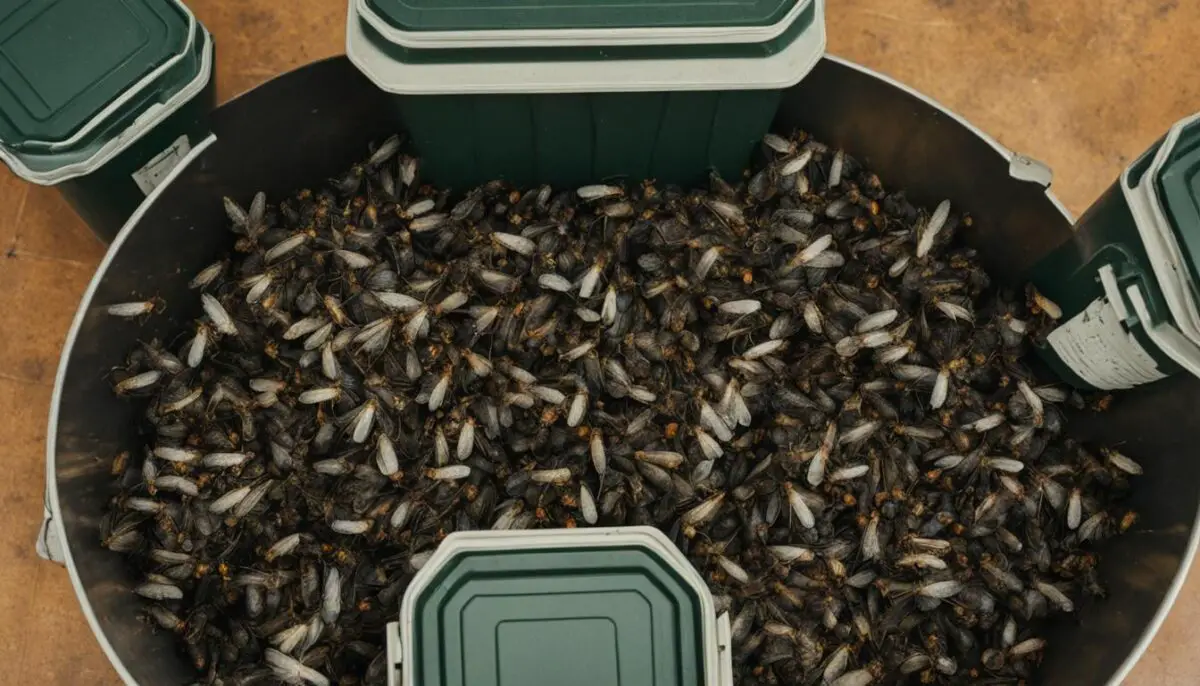House flies are a common nuisance in many households, buzzing around and making themselves unwelcome guests. But have you ever wondered where these pesky insects actually lay their eggs? Understanding their egg-laying habits can provide valuable insights into controlling and preventing house fly infestations in your home.
House flies tend to lay their eggs in specific locations, known as egg-laying sites or breeding grounds. These sites are characterized by certain conditions that are conducive to the development and survival of the fly larvae. By knowing where these sites are, you can take appropriate measures to eliminate them and reduce the fly population in your surroundings.
So, where do house flies prefer to lay their eggs? Let’s explore some of the common egg-laying sites or breeding grounds that house flies are naturally attracted to:
Key Takeaways:
- House flies lay their eggs in specific locations called egg-laying sites or breeding grounds.
- Understanding these breeding habits can help in controlling and preventing house fly infestations.
- Common egg-laying sites include garbage cans, compost bins, moist organic matter, manure piles, and decaying vegetation.
- By recognizing fly eggs and larvae, it becomes easier to identify potential breeding sites.
- Preventing fly infestations involves good sanitation, using fly traps and repellents, and eliminating sources of organic waste.
Factors that Attract House Flies
House flies are naturally drawn to specific sites that provide the ideal conditions for egg-laying. Understanding these fly egg deposition sites can help in effectively managing and preventing house fly infestations. Let’s explore some of the preferred locations for house fly egg-laying and the factors that attract these pesky insects.
Preferred Locations for House Fly Egg-Laying
House flies tend to lay their eggs in areas that offer an abundant food source and suitable environmental conditions. These preferred sites include:
- Organic decaying matter: House flies are attracted to areas with decomposing organic matter such as rotting fruits, vegetables, and animal carcasses. These provide ample nutrients for their larvae to thrive.
- Trash cans: Waste bins and garbage cans are prime locations for house fly egg-laying. The combination of discarded food and moisture makes them an ideal breeding ground.
- Pet waste: Backyards or public areas where pet waste is not properly disposed of can attract house flies. The organic matter present in pet feces serves as a suitable substrate for egg deposition.
- Leftover food: Any area where food is left uncovered or not cleaned up properly can attract house flies. These insects are particularly drawn to kitchens, dining areas, and outdoor barbecues.
Aside from finding suitable fly egg deposition sites, house flies are also attracted to homes with open doors and windows. This provides easy access to potential breeding areas and increases the likelihood of a fly infestation.
To further illustrate the preferred locations for house fly egg-laying, here is a comprehensive table:
| Egg-Laying Sites | Description |
|---|---|
| Organic decaying matter | Areas with decomposing organic matter like rotting fruits, vegetables, and animal carcasses. |
| Trash cans | Waste bins and garbage cans that contain discarded food and moisture. |
| Pet waste | Backyards or public areas with improperly disposed pet feces. |
| Leftover food | Areas where uncovered or poorly cleaned food is present, such as kitchens, dining areas, and outdoor barbecues. |
Understanding the factors that attract house flies to these locations is crucial in implementing effective control measures and preventing infestations. By eliminating or minimizing these attractive conditions, we can significantly reduce the presence of house flies and create a more hygienic environment.

Common House Fly Breeding Sites
House flies have specific habitats where they prefer to reproduce and complete their life cycle stages. Understanding these common breeding sites is crucial for identifying and eliminating potential infestation sources. The following are some of the primary locations where house flies lay their eggs:
- Garbage cans
- Compost bins
- Moist organic matter
- Manure piles
- Decaying vegetation
These breeding sites provide the necessary nutrients and moisture required for the development of fly larvae. House flies are attracted to these habitats due to the availability of organic material, which serves as food for both the adult flies and their offspring. By targeting and eliminating these preferred breeding grounds, it becomes easier to control the house fly population and prevent infestations.

Why are these habitats suitable for house fly reproduction?
House flies are attracted to environments that offer favorable conditions for their eggs and larvae to thrive. Garbage cans and compost bins provide ample organic waste, which serves as a food source for the developing larvae. Moist organic matter, such as decaying food and animal waste, creates an ideal environment for fly reproduction. Manure piles are also rich in nutrients and moisture, making them attractive breeding grounds. Similarly, decaying vegetation offers the necessary resources for fly larvae to complete their life cycle stages.
House flies have evolved to adapt and thrive in environments where organic waste is abundant. By understanding their preferred breeding habitats, we can effectively target these areas and minimize the risk of fly infestations.
The importance of eliminating potential infestation sources
Identifying and eliminating common house fly breeding sites is crucial for preventing infestations and maintaining a hygienic living environment. Regular sanitation practices, such as proper waste management and cleaning, can significantly reduce the chances of flies laying their eggs in and around your property. By breaking the house fly life cycle and removing their preferred habitats, you can effectively control their population and minimize the risk of fly-borne diseases.
| Common House Fly Breeding Sites | Key Characteristics |
|---|---|
| Garbage cans | Contain decaying food and organic waste |
| Compost bins | Provide moisture and organic matter |
| Moist organic matter | Includes decaying food, animal waste, and plant material |
| Manure piles | Rich in nutrients and moisture |
| Decaying vegetation | Offer resources for larvae development |
Eliminating these breeding sites involves proper waste disposal, regular cleaning, and ensuring that potential sources of organic waste are properly sealed or removed. By taking proactive measures, you can effectively reduce the presence of house flies and create a healthier living environment for you and your family.
Identifying Fly Eggs and Larvae
Being able to identify fly eggs and larvae is essential in understanding and managing house fly infestations. By recognizing the characteristics of these life stages, you can effectively locate and eliminate potential breeding sites. Here is what you need to know:
Fly Eggs
Fly eggs are typically small, white, and cylindrical in shape. They are approximately 1.2 mm in length, making them barely visible to the naked eye. House flies lay their eggs in clusters, which can contain anywhere from 75 to 150 eggs. These eggs are commonly found in areas where organic matter is present, such as trash bins, decaying food, or animal waste.
Fly Larvae (Maggots)
Once the fly eggs hatch, they develop into larvae, often referred to as maggots. Fly larvae are whitish in color and appear legless, resembling small worms. They undergo several molts, growing in size and feeding on the organic material surrounding them. The larvae stage typically lasts for about 4 to 10 days, depending on the environmental conditions.
It is crucial to identify fly eggs and larvae to effectively disrupt their life cycle and prevent future infestations. By eliminating their breeding sites and practicing good sanitation, you can minimize the presence of house flies in and around your home.
| Fly Eggs | Fly Larvae (Maggots) |
|---|---|
| Small, white, and cylindrical | Whitish and legless, resembling small worms |
| Found in clusters | Feed on organic matter |
| Approximately 1.2 mm in length | Undergo several molts |
| Often located in areas with decaying organic material | Lasts for 4 to 10 days |
Remember, swift identification and elimination of fly eggs and larvae are crucial in preventing house fly infestations and maintaining a clean and healthy living environment.

Preventing House Fly Infestations
Preventing house fly infestations is crucial to maintain a clean and hygienic living environment. By implementing effective control methods, you can deter flies from entering and breeding in your home. Here are some essential measures to keep in mind:
- Install Screen Doors and Windows: To keep flies out, consider installing screen doors and windows. These protective barriers allow fresh air to enter while preventing flies from accessing your living areas.
- Keep Doors and Windows Closed: During peak fly season, make a habit of keeping all doors and windows closed. This simple step reduces the likelihood of flies finding their way inside your home.
- Practice Good Sanitation: Maintaining proper sanitation is essential for fly control. Seal food in airtight containers to deny flies access to potential food sources. Additionally, keeping your home clean and free from organic waste minimizes attractive breeding sites for flies.
- Use Fly Traps and Repellents: Utilize fly traps and repellents as part of your fly control strategy. Fly traps, such as sticky fly tape, attract and capture flies, reducing their population. Repellents can also deter flies from entering your home.
- Regularly Clean Out Trash Cans: Flies are attracted to trash cans where they find organic waste to feed on. Ensure to regularly clean out your trash cans and dispose of waste properly to prevent flies from breeding in them.
- Eliminate Sources of Organic Waste: Minimize the presence of organic waste that attracts flies by regularly cleaning up after pets, properly disposing of food scraps, and maintaining clean outdoor spaces. By removing these favorable breeding conditions, you can effectively prevent house fly infestations.
By following these preventive measures, you can significantly reduce the risk of house fly infestations in your home. Remember, maintaining a clean and hygienic environment is key to keeping flies at bay.
 <!– Table:
<!– Table:
Comparison of House Fly Control Methods
| Control Method | Pros | Cons |
|---|---|---|
| Fly Traps | – Effective in capturing flies – Easy to use |
– May require regular maintenance and replacement of traps – May not completely eliminate all flies |
| Chemical Sprays | – Instantly kills flies – Wide availability |
– Chemical exposure to humans and pets if not used properly – May require repeated applications |
| Biological Control (e.g., predator insects) | – Natural and eco-friendly – Targets fly larvae and reduces reproduction |
– May take time to establish a population of predator insects – Effectiveness can vary depending on the environment |
| Cultural Practices | – Maintaining good sanitation reduces fly breeding areas – Sustainable and long-lasting solution |
– May require consistent effort and habit changes – Requires ongoing maintenance |
| Ultrasonic Devices | – Claimed to repel flies and other pests – No chemicals or traps involved |
– Limited evidence of effectiveness – May not work against all fly species |
–>
Eliminating Fly Breeding Sites
To effectively eliminate fly breeding sites and prevent fly eggs from hatching, it is crucial to identify and address potential sources of infestation. By taking proactive measures and implementing good sanitation practices, you can significantly reduce the risk of fly infestations in your home and surrounding areas.
Here are some essential steps to follow:
1. Proper Garbage Management
Garbage cans and bins are attractive breeding sites for flies. To prevent fly eggs from hatching, make sure to:
- Cover or seal garbage containers tightly to avoid flies from accessing the contents.
- Regularly clean and disinfect garbage cans to eliminate any residue that may attract flies.
- Dispose of garbage in sealed bags and promptly remove from your property.
2. Compost Bin Maintenance
If you have a compost bin, it’s essential to manage it properly to avoid becoming a breeding ground for flies:
- Seal the compost bin tightly to prevent flies from entering and laying eggs.
- Turn the compost regularly to promote proper decomposition and discourage fly breeding.
- Avoid adding meat, dairy, or oily food waste to the compost bin, as these items attract flies.
3. Drain Cleaning
Unclean drains can accumulate organic matter and provide a favorable environment for fly breeding. To prevent this:
- Regularly clean and sanitize drains using a drain cleaner or a mixture of hot water and vinegar.
- Ensure drains are covered with grates or screens to prevent flies from accessing them.
- Fix any leaks or plumbing issues to minimize moisture buildup, which attracts flies.
4. Fruit and Vegetable Disposal
Overripe or rotting fruit and vegetables are prime targets for fly infestation. To keep flies away:
- Regularly inspect your fruit bowl and discard any spoiled or overripe produce.
- Dispose of fruit and vegetable scraps in sealed bags or containers, and promptly remove them from your home.
5. Cleaning and Sanitization
Maintaining a clean and sanitary environment is crucial in preventing fly infestations. Make sure to:
- Regularly clean your home, paying special attention to areas prone to food spills or organic waste accumulation.
- Store food in sealed containers to prevent attracting flies.
- Keep pet areas clean by promptly removing waste and regularly cleaning their living spaces.
By implementing these preventive measures, you can effectively eliminate fly breeding sites and prevent fly eggs from hatching, reducing the chances of a house fly infestation. Remember, consistency is key in maintaining a fly-free environment.
| Methods to Eliminate Fly Breeding Sites | Effectiveness | Difficulty Level |
|---|---|---|
| Proper garbage management | Highly effective | Easy |
| Compost bin maintenance | Effective | Moderate |
| Drain cleaning | Effective | Moderate |
| Fruit and vegetable disposal | Effective | Easy |
| Cleaning and sanitization | Highly effective | Easy |
Conclusion
Controlling house fly infestations and managing fly breeding sites is crucial for maintaining a clean and healthy home environment. These flying pests not only annoy us but also pose health risks by carrying disease-causing organisms. By understanding their breeding habits and implementing preventive measures, you can effectively reduce the population of house flies.
A key step in house fly infestation control is regular cleaning. Cleaning your home thoroughly and frequently helps eliminate any potential food or organic matter that may attract flies. Additionally, practicing good sanitation practices, such as sealing food in airtight containers and regularly cleaning trash cans, can minimize fly breeding sites.
Proper waste management is also crucial in managing fly breeding sites. By covering or removing garbage containers, sealing compost bins, and removing overripe fruits and vegetables from your surroundings, you can reduce the availability of food sources for house flies. Keeping your drains clean and removing any stagnant water further disrupts their breeding cycle.
In summary, by implementing these preventive measures and maintaining a clean and sanitary environment, you can significantly reduce the house fly population and minimize the risk of infestation. Remember, house fly infestation control and managing fly breeding sites require consistent efforts, but the benefits of a fly-free living space make it well worth it.
FAQ
Where do house flies lay their eggs?
House flies tend to lay their eggs in specific locations known as egg-laying sites or breeding grounds. These sites are typically characterized by conditions conducive to the development and survival of fly larvae.
What are some factors that attract house flies to lay eggs?
House flies are attracted to sites where they can find suitable conditions for egg-laying. These sites often include organic decaying matter, trash cans, pet waste, areas with leftover food, and homes with open doors and windows.
What are common house fly breeding sites?
Common house fly breeding sites include garbage cans, compost bins, moist organic matter, manure piles, and decaying vegetation. These sites provide the necessary nutrients and moisture for the development of fly larvae.
How can I identify fly eggs and larvae?
House fly eggs are small, white, and cylindrical in shape, often found in clusters. The larvae, or maggots, are whitish and legless, resembling small worms. Recognizing these stages in the house fly life cycle can help locate and eliminate potential breeding sites.
How can I prevent house fly infestations?
Preventing house fly infestations involves installing screen doors and windows, keeping doors and windows closed, practicing good sanitation, using fly traps and repellents, and regularly cleaning out trash cans. These measures help deter flies from entering and breeding in the home.
How can I eliminate fly breeding sites?
To eliminate fly breeding sites, it is important to cover or remove garbage containers, seal compost bins, clean drains, remove overripe fruit and vegetables, and maintain a clean and sanitary environment. By disrupting the fly life cycle and eliminating breeding sites, it becomes easier to control and prevent fly infestations.
How can I control house fly infestations?
By understanding house fly breeding habits and implementing preventive measures, it is possible to control and manage fly infestations effectively. Regular cleaning, good sanitation practices, and proper waste management are key in preventing fly eggs from hatching and reducing the population of house flies in and around the home.

